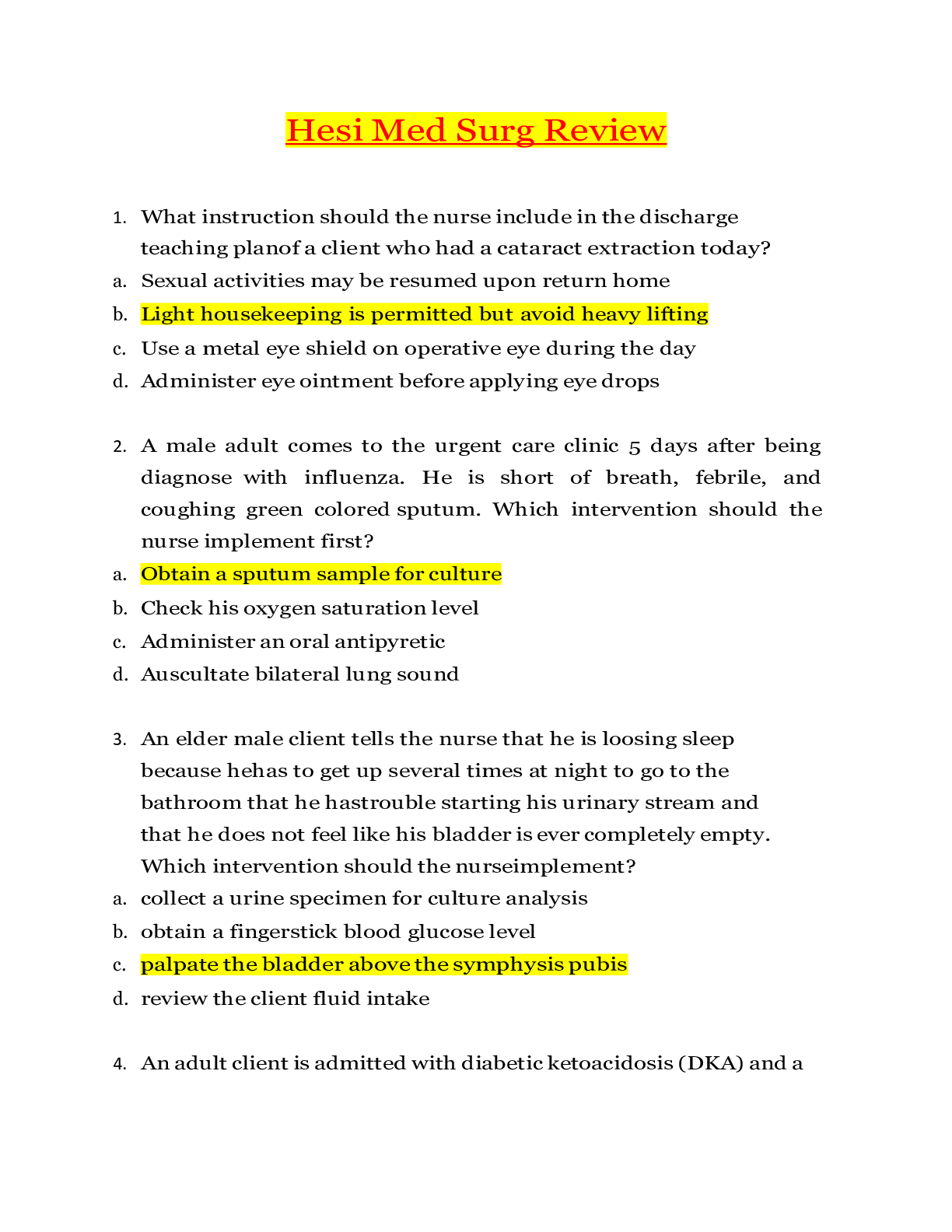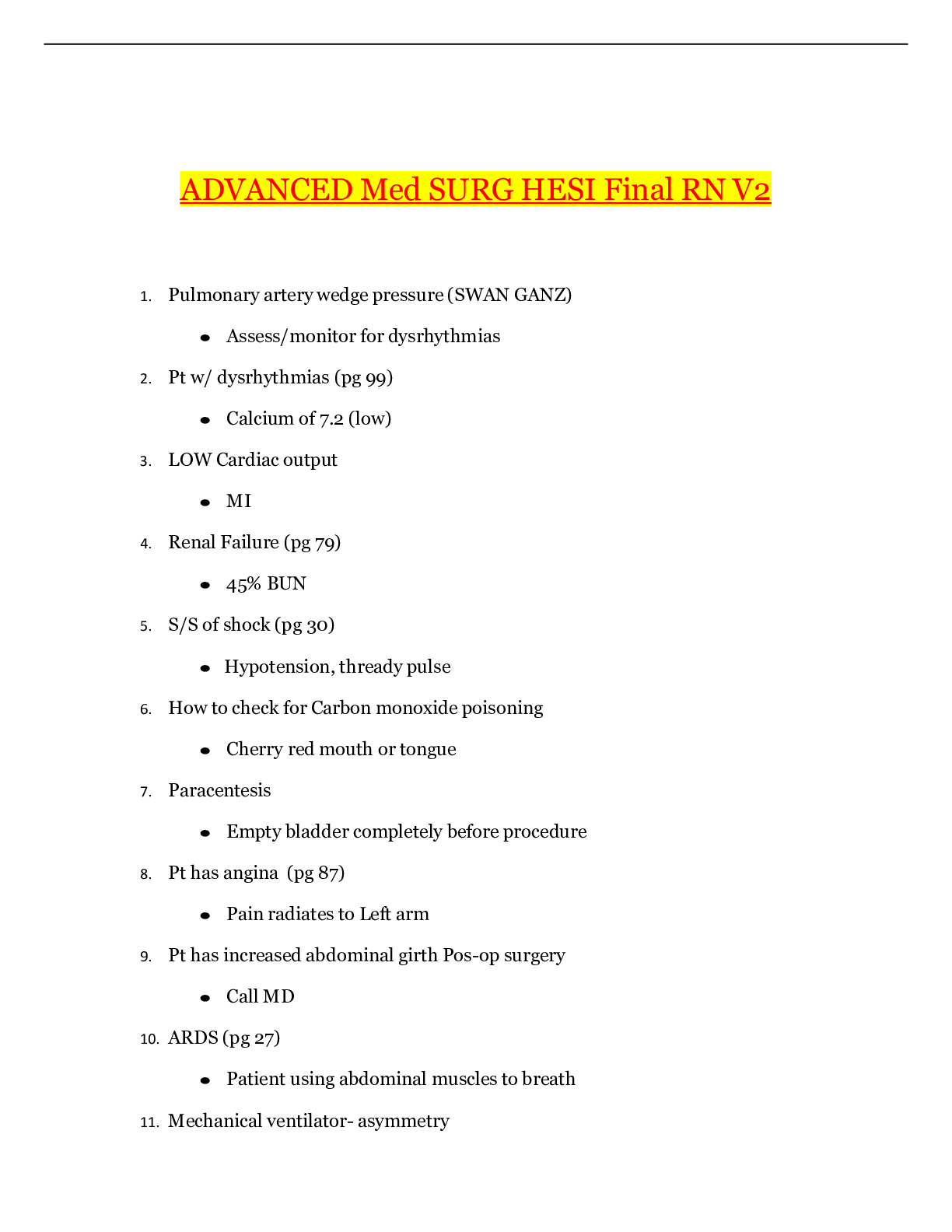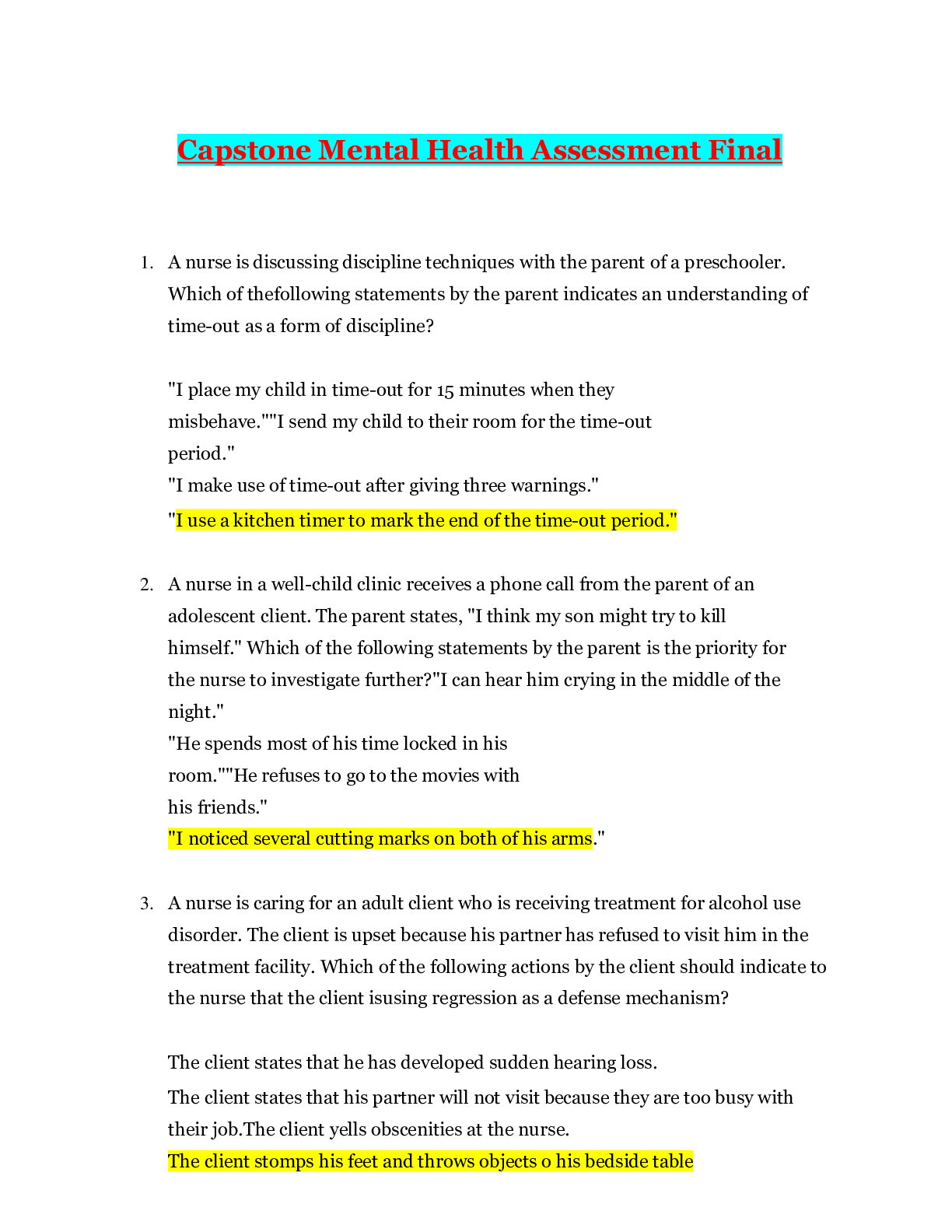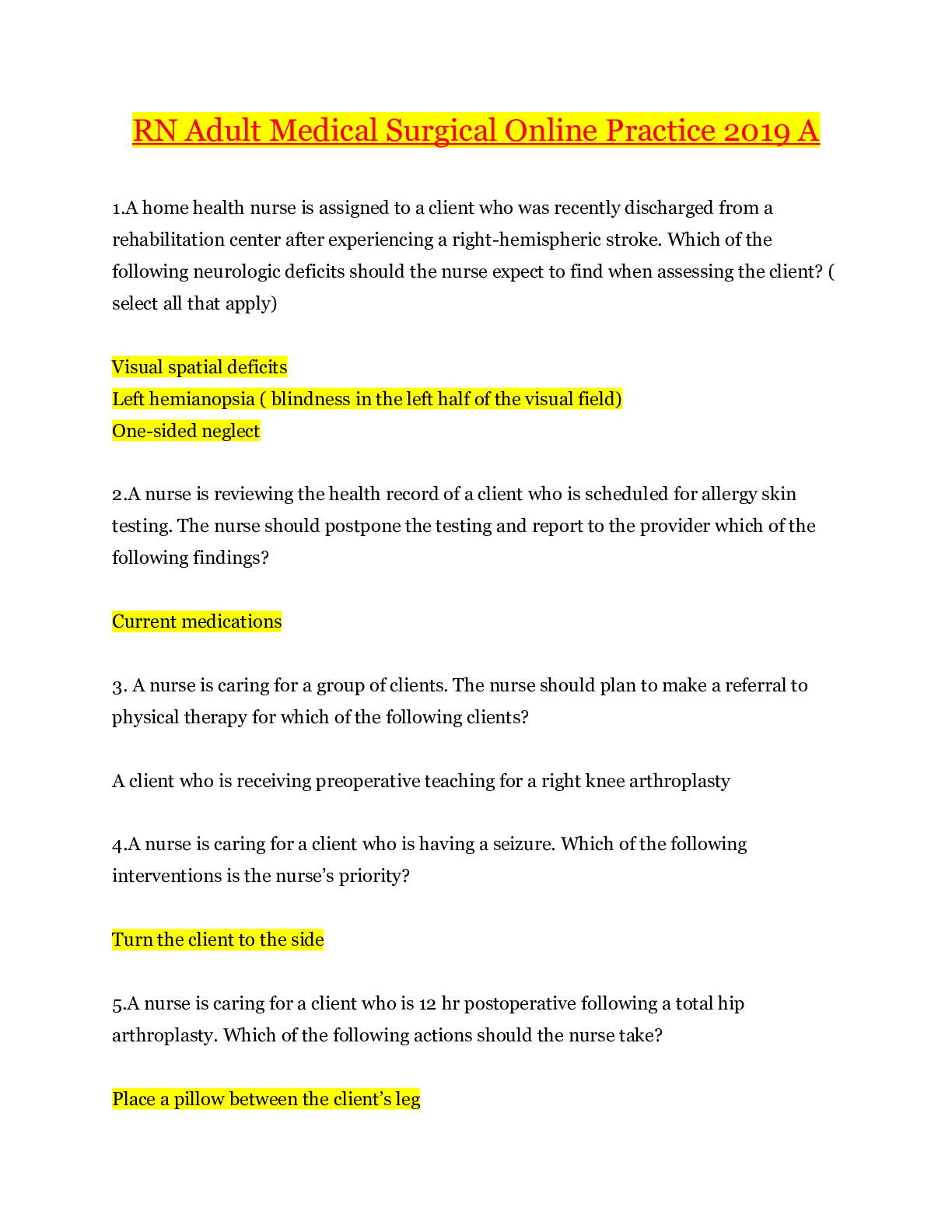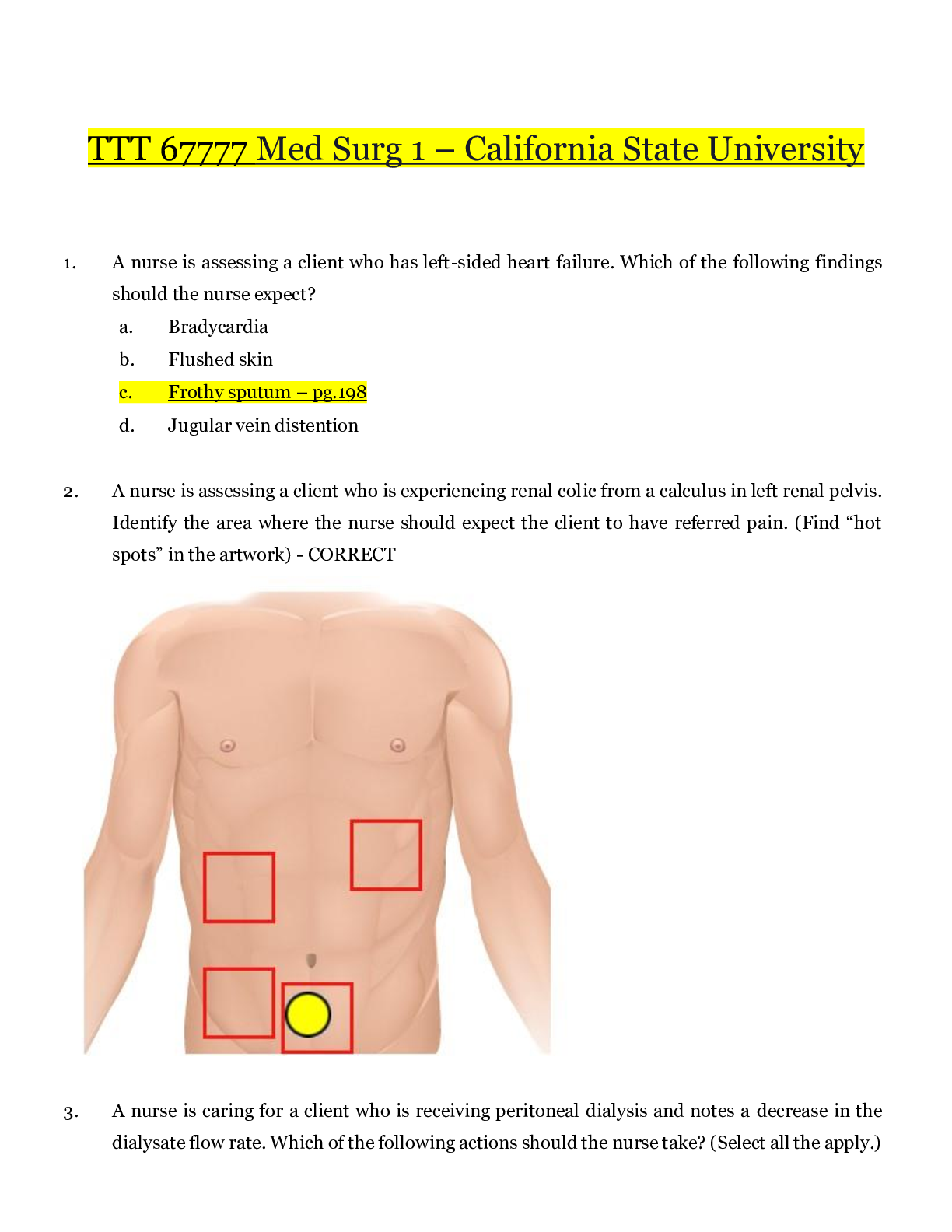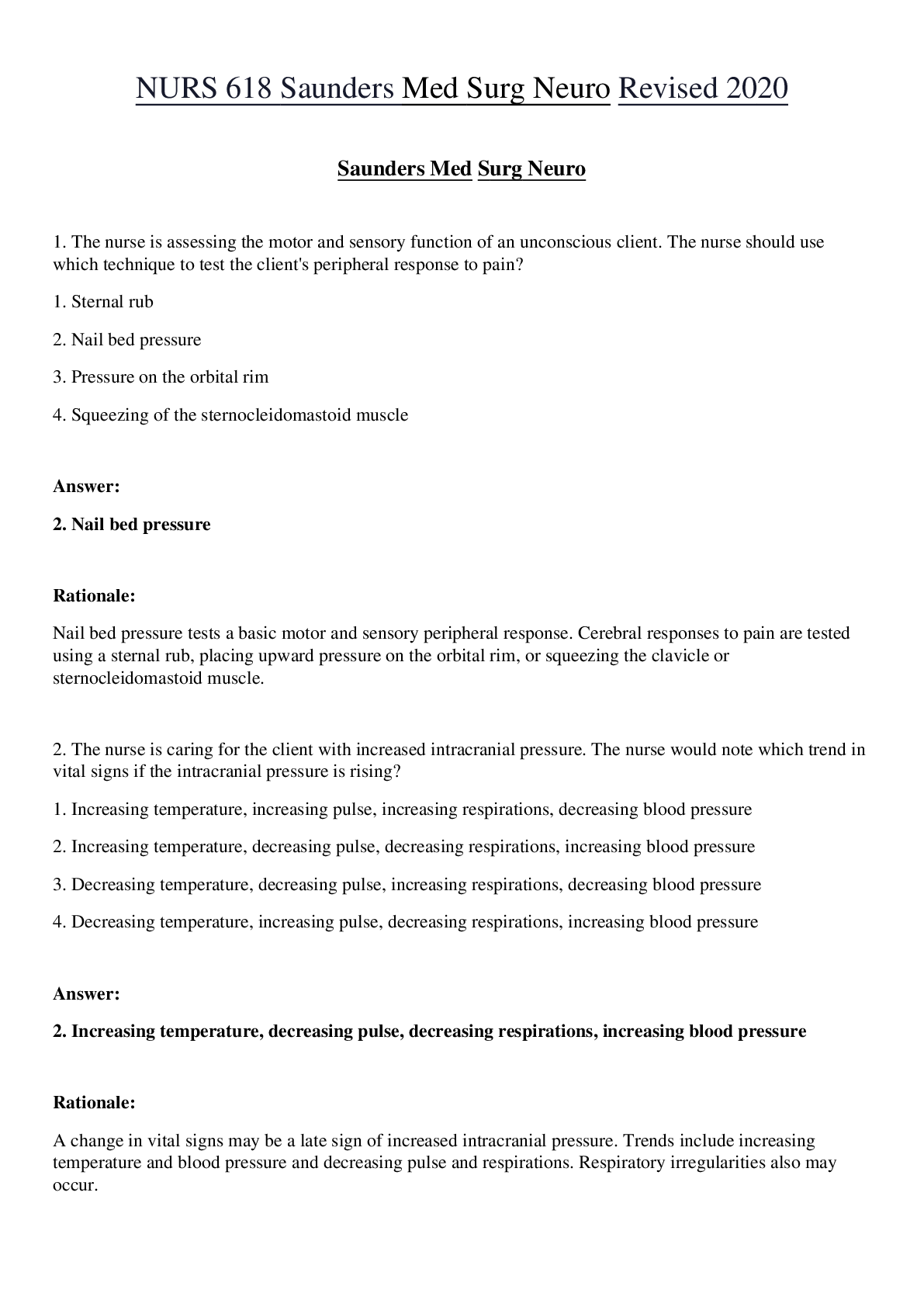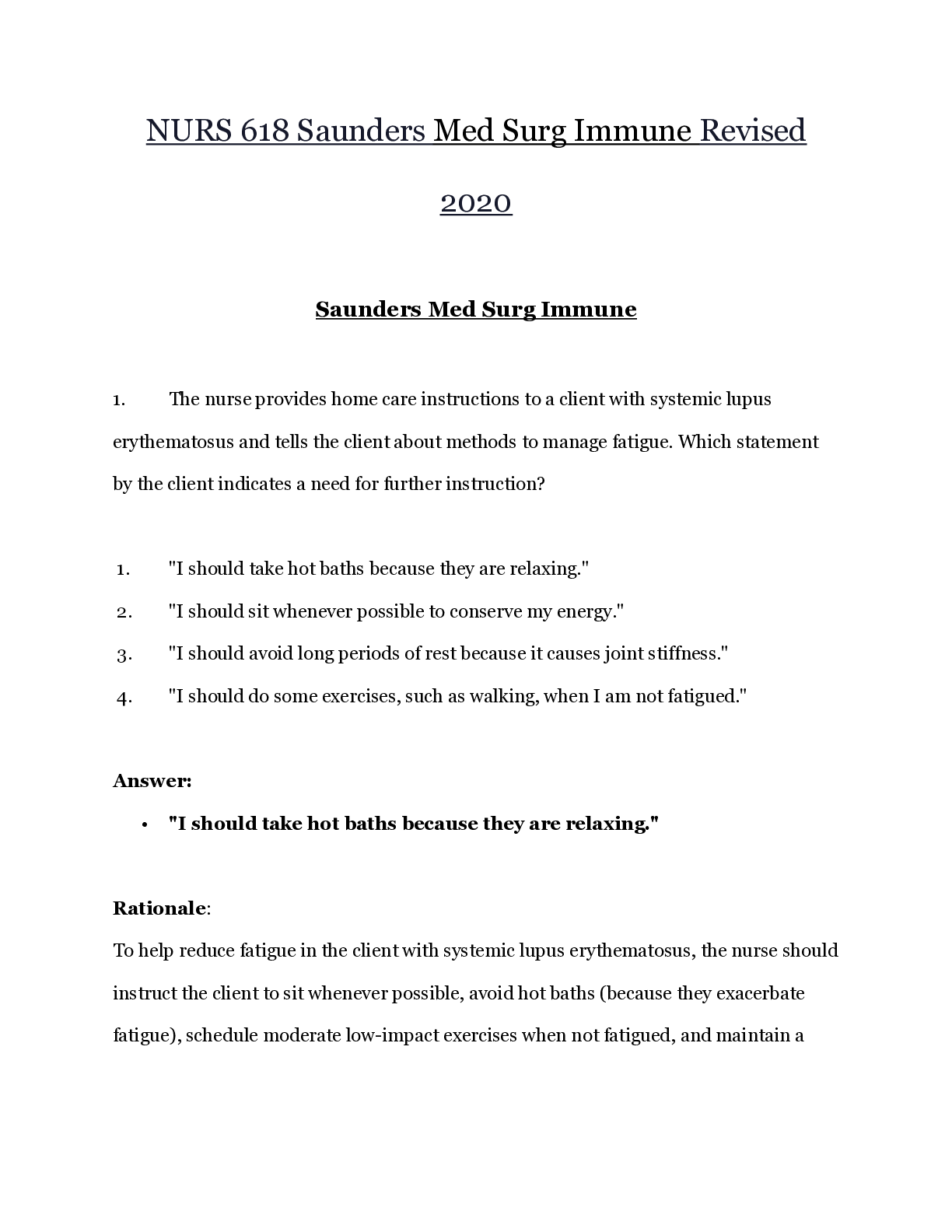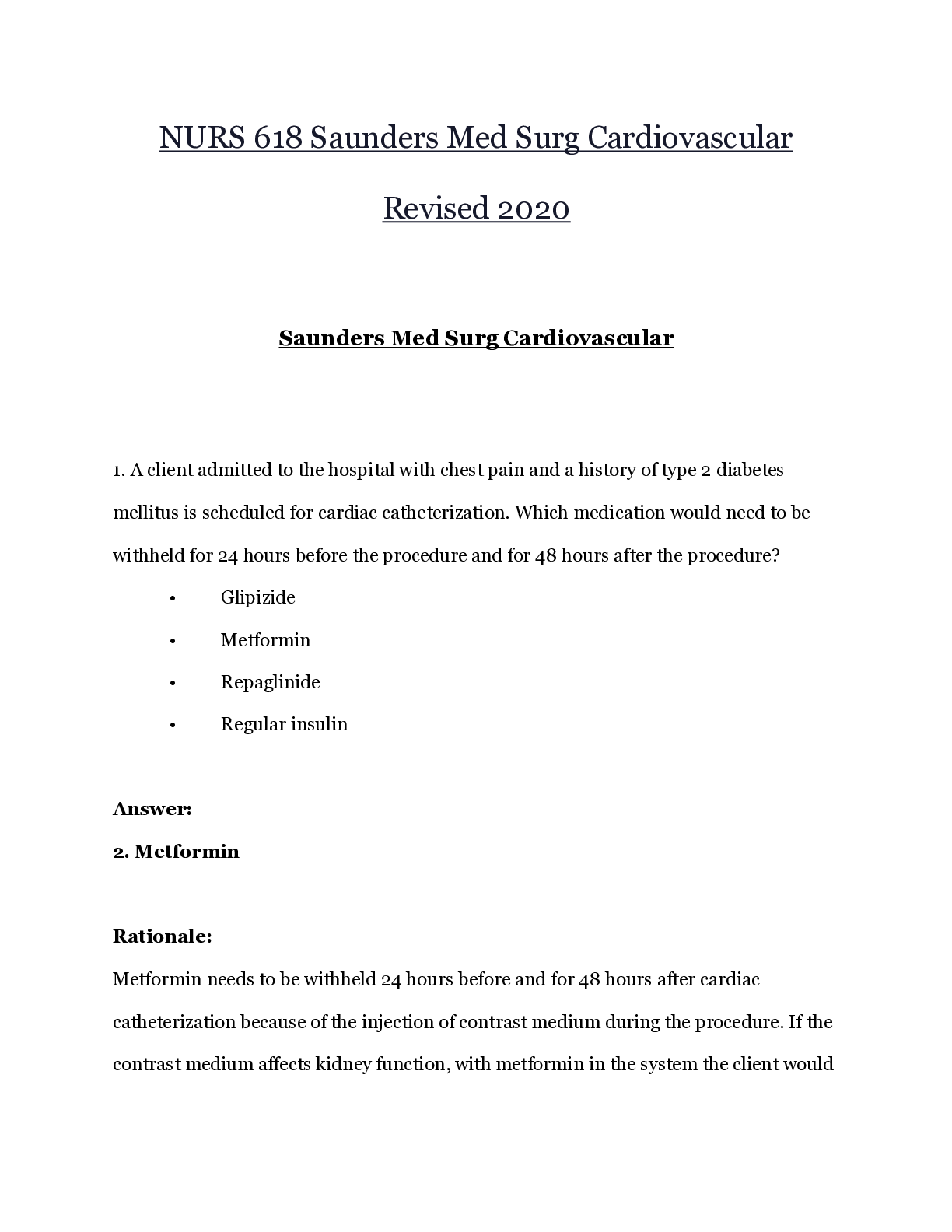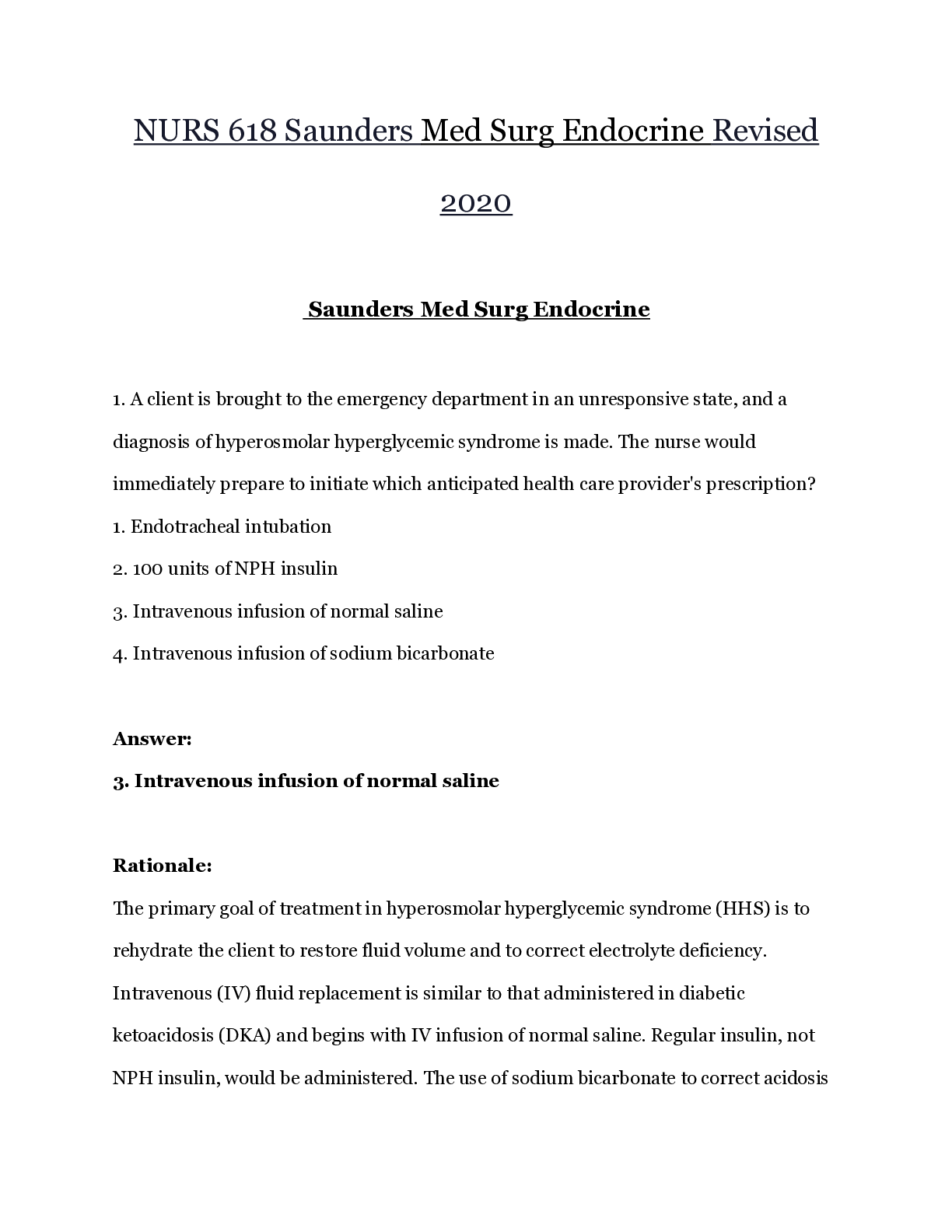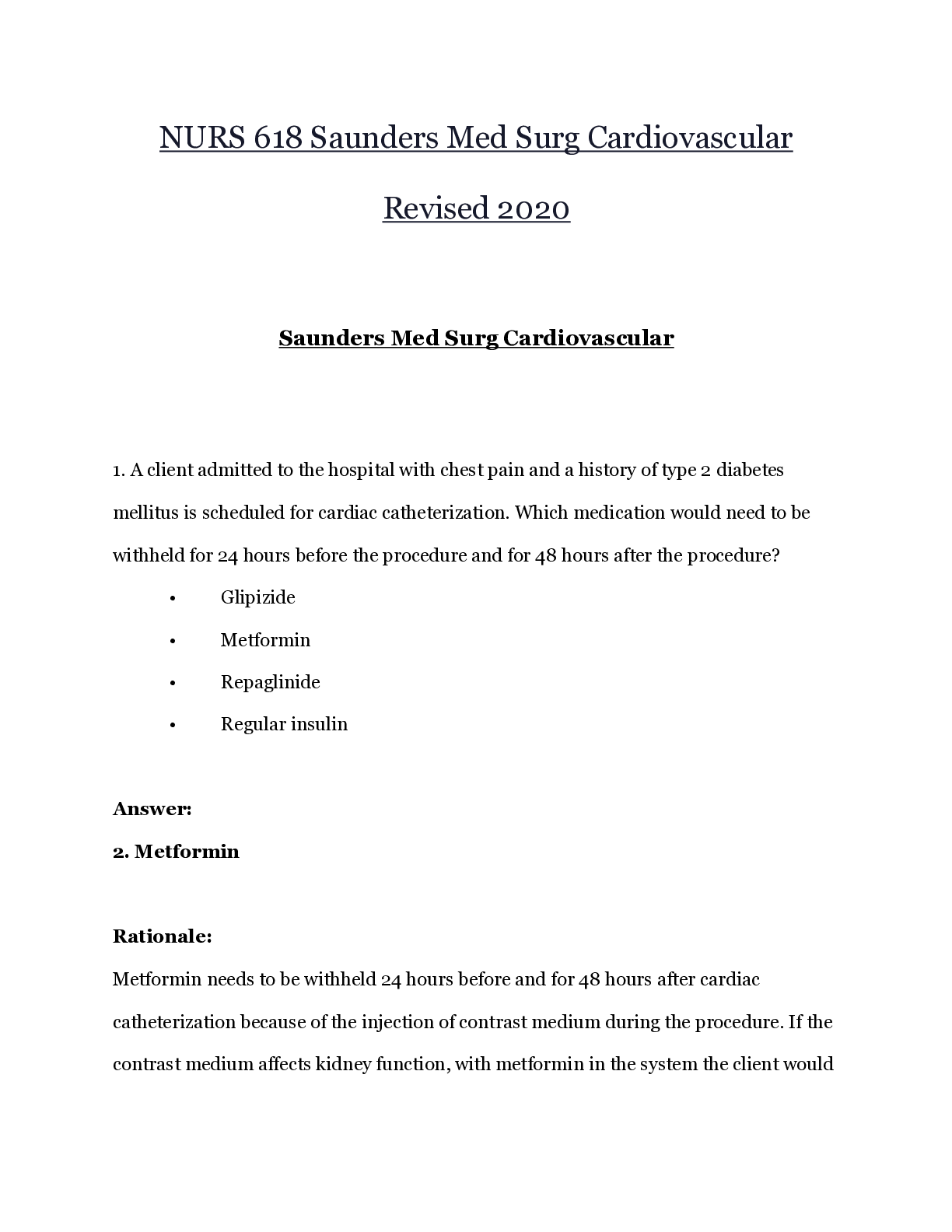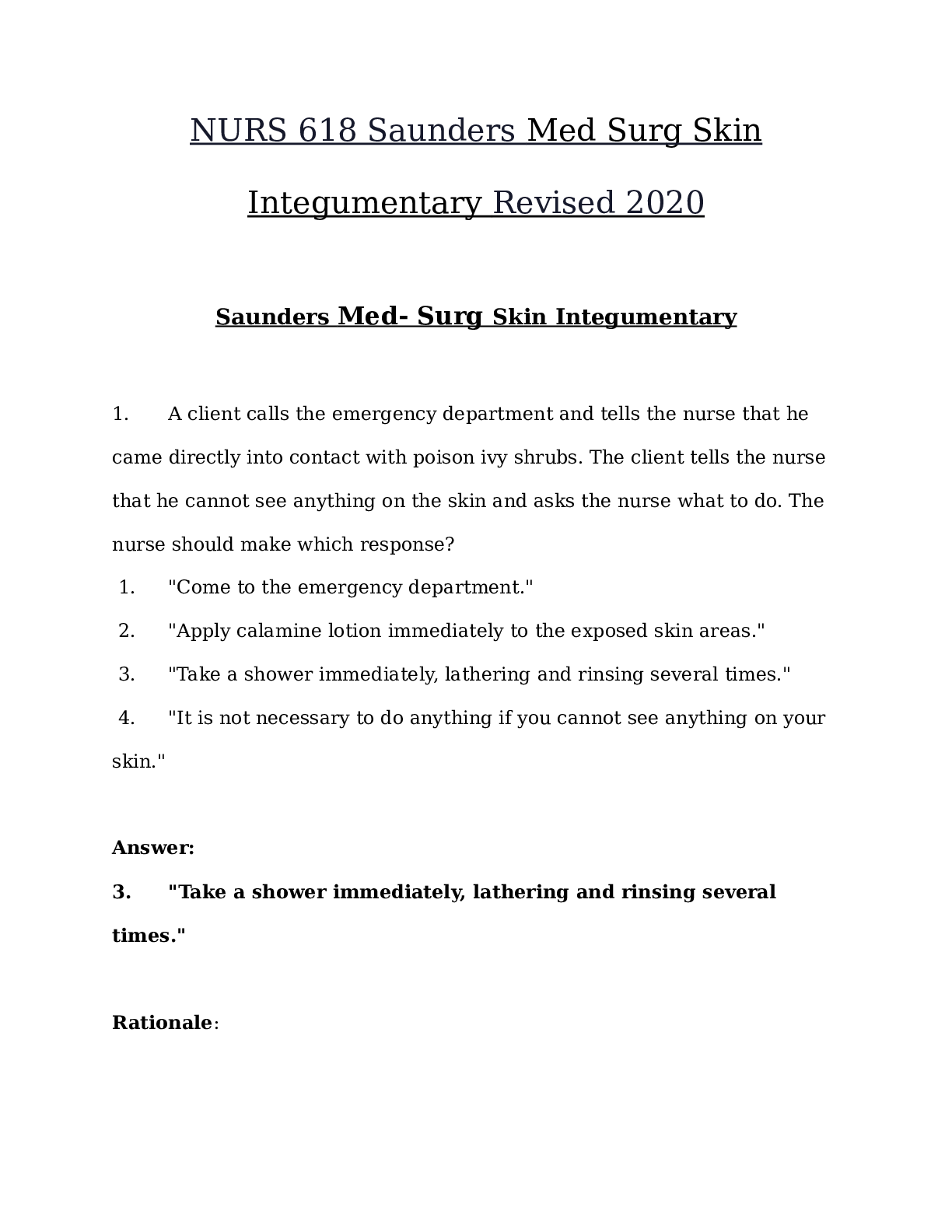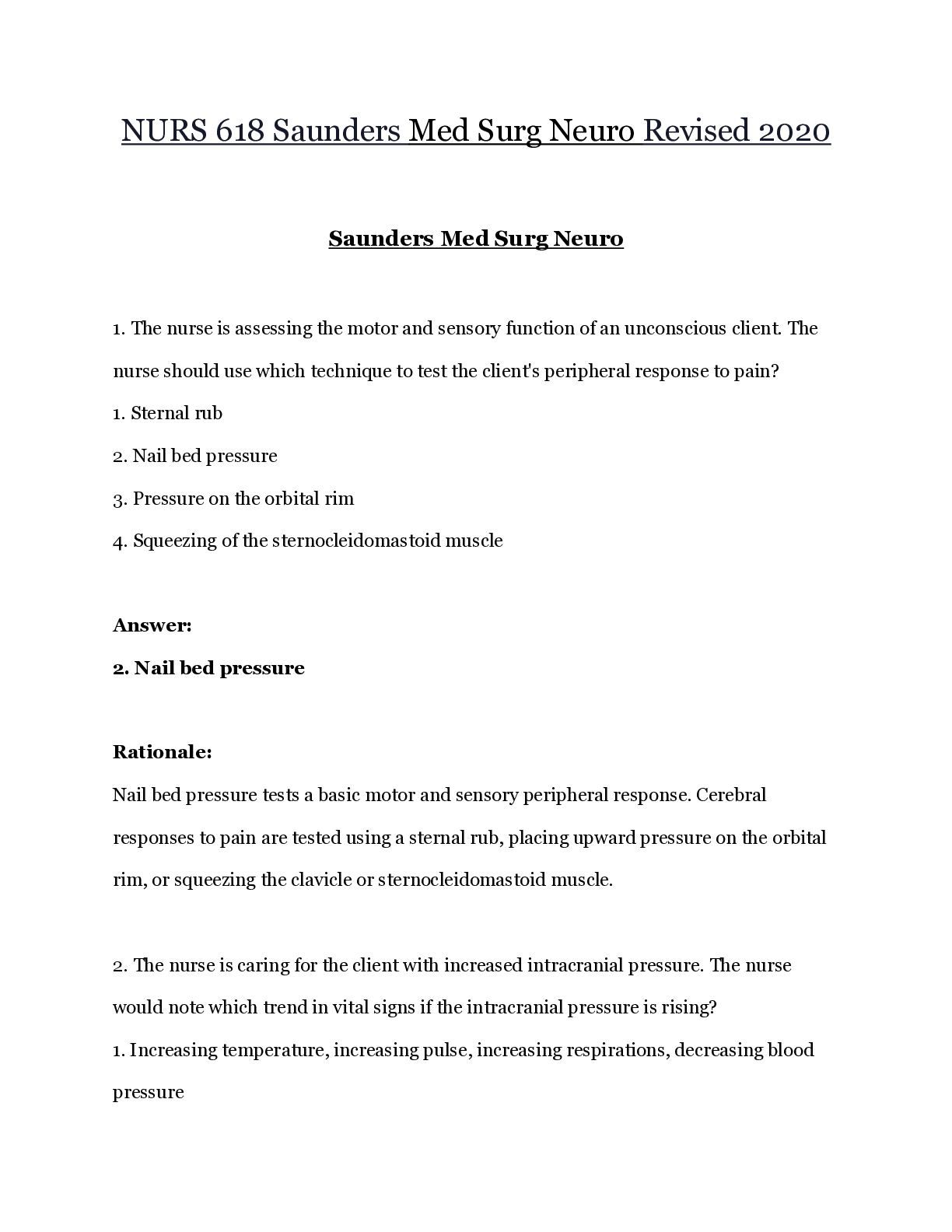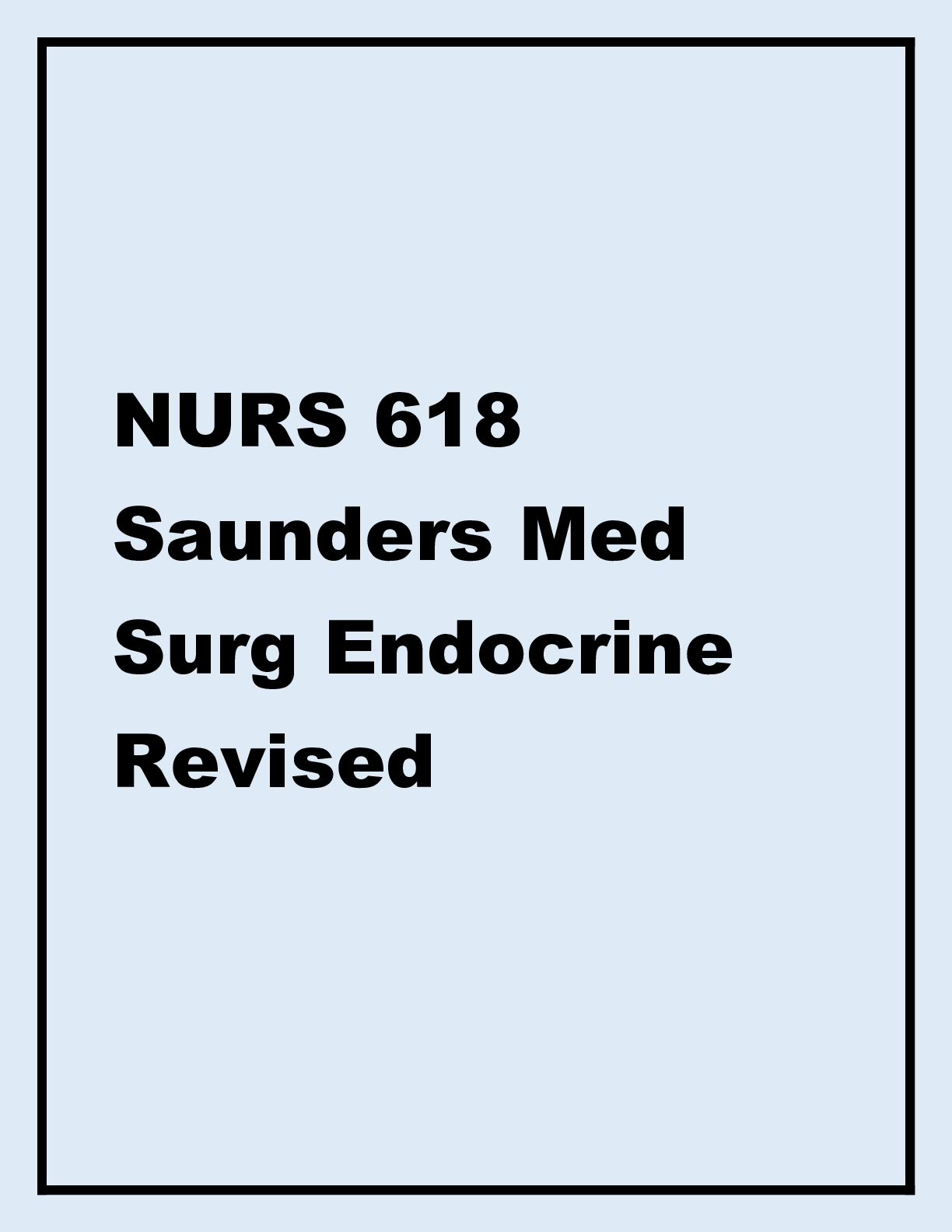*NURSING > MED-SURG EXAM > NURS 618 Saunders Med Surg Endocrine Revised 2020 | NURS618 Saunders Med Surg Endocrine (All)
NURS 618 Saunders Med Surg Endocrine Revised 2020 | NURS618 Saunders Med Surg Endocrine
Document Content and Description Below
NURS 618 Saunders Med Surg Endocrine Revised 2020 Saunders Med Surg Endocrine 100+ pages of questions with answers 1. A client is brought to the emergency department in an unresponsive state, and a... diagnosis of the hyperosmolar hyperglycemic syndrome is made. The nurse would immediately prepare to initiate which anticipated health care provider's prescription? 1. Endotracheal intubation 2. 100 units of NPH insulin 3. Intravenous infusion of normal saline 4. Intravenous infusion of sodium bicarbonate Answer: 3. Intravenous infusion of normal saline Rationale: The primary goal of treatment in hyperosmolar hyperglycemic syndrome (HHS) is to rehydrate the client to restore fluid volume and to correct electrolyte deficiency. Intravenous (IV) fluid replacement is similar to that administered in diabetic ketoacidosis (DKA) and begins with IV infusion of normal saline. Regular insulin, not NPH insulin, would be administered. The use of sodium bicarbonate to correct acidosisis avoided because it can precipitate a further drop in serum potassium levels. Intubation and mechanical ventilation are not required to treat HHS. 2. An external insulin pump is prescribed for a client with diabetes mellitus. When the client asks the nurse about the functioning of the pump, the nurse bases the response on which information about the pump? 1. It is timed to release programmed doses of either short-duration or NPH insulin into the bloodstream at specific intervals. 2. It continuously infuses small amounts of NPH insulin into the bloodstream while regularly monitoring blood glucose levels. 3. It is surgically attached to the pancreas and infuses regular insulin into the pancreas. This releases insulin into the bloodstream. 4. It administers a small continuous dose of short-duration insulin subcutaneously. The client can self-administer an additional bolus dose from the pump before each meal. Answer: 4. It administers a small continuous dose of short-duration insulin subcutaneously. The client can self-administer an additional bolus dose from the pump before each meal. Rationale: An insulin pump provides a small continuous dose of short-duration (rapid- or shortacting) insulin subcutaneously throughout the day and night. The client can selfadminister an additional bolus dose from the pump before each meal as needed. Shortduration insulin 3. A client with a diagnosis of diabetic ketoacidosis (DKA) is being treated in the emergency department. Which findings support this diagnosis? Select all that apply. 1. Increase in pH 2. Comatose state 3. Deep, rapid breathing 4. Decreased urine output 5. Elevated blood glucose level Answers: 2. Comatose state 3. Deep, rapid breathing 5. Elevated blood glucose level Rationale: Because of the profound deficiency of insulin associated with DKA, glucose cannot be used for energy and the body breaks down fat as a secondary source of energy. Ketones, which are acid byproducts of fat metabolism, build up and the client experiences a metabolic ketoacidosis. High serum glucose contributes to an osmotic diuresis and the client becomes severely dehydrated. If untreated, the client will become comatose due to severe dehydration, acidosis, and electrolyte imbalance. Kussmaul's respirations, the deep rapid breathing associated with DKA, is a compensatory mechanism by the body.The body attempts to correct the acidotic state by blowing off carbon dioxide (CO2), which is an acid. In the absence of insulin, the client will experience severe hyperglycemia. Option 1 is incorrect because in acidosis the pH would be low. Option 4 is incorrect because a high serum glucose will result in an osmotic diuresis and the client will experience polyuria. 4. The nurse teaches a client with diabetes mellitus about differentiating between hypoglycemia and ketoacidosis. The client demonstrates an understanding of the teaching by stating that a form of glucose should be taken if which symptom or symptoms develop? Select all that apply. 1. Polyuria 2. Shakiness 3. Palpitations 4. Blurred vision 5. Lightheadedness 6. Fruity breath odor Answers: 2. Shakiness 3. Palpitations 5. Lightheadedness Rationale:Shakiness, palpitations, and lightheadedness are signs/symptoms of hypoglycemia and would indicate the need for food or glucose. Polyuria, blurred vision, and a fruity breath odor are manifestations of hyperglycemia. 5. A client with diabetes mellitus demonstrates acute anxiety when admitted to the hospital for the treatment of hyperglycemia. What is the appropriate intervention to decrease the client's anxiety? 1. Administer a sedative. 2. Convey empathy, trust, and respect toward the client. 3. Ignore the signs and symptoms of anxiety, anticipating that they will soon disappear. 4. Make sure that the client is familiar with the correct medical terms to promote understanding of what is happening. Answer: 2. Convey empathy, trust, and respect toward the client. Rationale: Anxiety is a subjective feeling of apprehension, uneasiness, or dread. The appropriate intervention is to address the client's feelings related to the anxiety. Administering a sedative is not the most appropriate intervention and does not address the source of the client's anxiety. The nurse should not ignore the client's anxious feelings. Anxiety needs to be managed before meaningful client education can occur.6. The nurse provides instructions to a client newly diagnosed with type 1 diabetes mellitus. The nurse recognizes accurate understanding of measures to prevent diabetic ketoacidosis when the client makes which statement? 1. "I will stop taking my insulin if I'm too sick to eat." 2. "I will decrease my insulin dose during times of illness." 3. "I will adjust my insulin dose according to the level of glucose in my urine." 4. "I will notify my health care provider (HCP) if my blood glucose level is higher than 250 mg/dL (14.2 mmol/L)." Answer: 4. "I will notify my health care provider (HCP) if my blood glucose level is higher than 250 mg/dL (14.2 mmol/L)." Rationale: During illness, the client with type 1 diabetes mellitus is at increased risk of diabetic ketoacidosis, due to hyperglycemia associated with the stress response and due to a typically decreased caloric intake. As part of sick day management, the client with diabetes should monitor blood glucose levels and should notify the HCP if the level is higher than 250 mg/dL (14.2 mmol/L). Insulin should never be stopped. In fact, insulin may need to be increased during times of illness. Doses should not be adjusted without the HCP's advice and are usually adjusted on the basis of blood glucose levels, not urinary glucose readings.7. A client is admitted to a hospital with a diagnosis of diabetic ketoacidosis (DKA). The initial blood glucose level is 950 mg/dL (54.2 mmol/L). A continuous intravenous (IV) infusion of short-acting insulin is initiated, along with IV rehydration with normal saline. The serum glucose level is now decreased to 240 mg/dL (13.7 mmol/L). The nurse would next prepare to administer which medication? 1. An ampule of 50% dextrose 2. NPH insulin subcutaneously 3. IV fluids containing dextrose 4. Phenytoin for the prevention of seizures Answer: 3. IV fluids containing dextrose Rationale: Emergency management of DKA focuses on correcting fluid and electrolyte imbalances and normalizing the serum glucose level. If the corrections occur too quickly, serious consequences, including hypoglycemia and cerebral edema, can occur. During management of DKA, when the blood glucose level falls to 250 to 300 mg/dL (14.2 to 17.1 mmol/L), the IV infusion rate is reduced and a dextrose solution is added to maintain a blood glucose level of about 250 mg/dL (14.2 mmol/L), or until the client recovers from ketosis. Fifty percent dextrose is used to treat hypoglycemia. NPH insulin is not used to treat DKA. Phenytoin is not a usual treatment measure for DKA.8. The nurse is monitoring a client newly diagnosed with diabetes mellitus for signs of complications. Which sign or symptom, if exhibited in the client, indicates that the client is at risk for chronic complications of diabetes if the blood glucose is not adequately managed? 1. Polyuria 2. Diaphoresis 3. Pedal edema 4. Decreased respiratory rate Answer: 1. Polyuria Rationale: Chronic hyperglycemia, resulting from poor glycemic control, contributes to the microvascular and macrovascular complications of diabetes mellitus. Classic symptoms of hyperglycemia include polydipsia, polyuria, and polyphagia. Diaphoresis may occur in hypoglycemia. Hypoglycemia is an acute complication of diabetes mellitus; however, it does not predispose a client to the chronic complications of diabetes mellitus. Therefore, option 2 can be eliminated because this finding is characteristic of hypoglycemia. Options 3 and 4 are not associated with diabetes mellitus.- - - - - - - - - - - - - - - - - - - - - - - - - - - - - - - - - - - - - 172. The nurse teaches a class on foot care for clients diagnosed with diabetes mellitus. Which instructions should the nurse include in the class? Select all that apply. 1. Wear closed-toe shoes. 2. Soak feet in hot water twice a day. 3. Massage lanolin lotion between the toes. 4. Cut toenails straight across and file the edges. 5. Pat feet dry gently, especially between the toes. Answers: 1. Wear closed-toe shoes.4. Cut toenails straight across and file the edges. 5. Pat feet dry gently, especially between the toes. Rationale: People with diabetes mellitus are at high risk for foot ulcerations and resultant lower extremity amputations. The development of diabetic foot complications can be the result of a combination of microvascular and macrovascular diseases that place the client at risk for injury and serious infection. Options 1, 4, and 5 are correct, as measures should be taken to teach clients how to prevent foot ulcers and injury. These measures include wearing closed-toe shoes to protect the feet and toes (especially for those with peripheral neuropathy), cutting toenails straight across and filing the edges to avoid sharp toenail edges and cutting the skin of the toe, and drying the feet gently and thoroughly (including between the toes) to prevent maceration of the skin and infections. Option 2 is incorrect, as clients with diabetes should avoid hot water due to neuropathy and possible burns. Option 3 is incorrect, as lotion between the toes is not advised; it is necessary to keep the area between the toes dry to avoid maceration and infections. 174. A client is admitted with suspected diabetic ketoacidosis (DKA). Which clinical manifestations best support a diagnosis of DKA? 1. Blood glucose 500 mg/dL (27.8 mmol/L); arterial blood gases: pH 7.30, PaCo2 50, HCO3– 26. 2. Blood glucose 400 mg/dL (22.2 mmol/L); arterial blood gases: pH 7.38, PaCo2 40, HCO3– 22.3. Blood glucose 450 mg/dL (25.0 mmol/L); arterial blood gases: pH 7.48, PaCo2 39, HCO3– 29. 4. Blood glucose 350 mg/dL (19.4 mmol/L); arterial blood gases: pH 7.28, PaCo2 30, HCO3– 14. Answer: 4. Blood glucose 350 mg/dL (19.4 mmol/L); arterial blood gases: pH 7.28, PaCo2 30, HCO3– 14. Rationale: DKA is caused by a profound deficiency of insulin and is characterized by hyperglycemia (blood glucose level greater than or equal to 250 mg/dL [13.9 mmol/L]), ketosis (ketones in urine or serum), metabolic acidosis, and dehydration. The correct option is 4, as it represents an elevated blood glucose and the arterial blood gases (ABGs) indicate metabolic acidosis. Option 1 is incorrect, as the ABGs indicate respiratory acidosis; option 2 is incorrect, as the ABG values are within normal; and option 3 is incorrect, as the ABGs indicate metabolic alkalosis. 175. The nurse is monitoring a diabetic client with a blood glucose level of 400 mg/dL (22.2 mmol/L). Which clinical manifestation would indicate diabetic ketoacidosis (DKA)? 1. Bradycardia 2. Cool, clammy skin 3. Lower extremity edema4. Rapid, deep respirations Answer: 4. Rapid, deep respirations Rationale: DKA is caused by a profound deficiency of insulin and is characterized by hyperglycemia (blood glucose level greater than or equal to 250 mg/dL [13.9 mmol/L]), ketosis (ketones in urine or serum), metabolic acidosis, and dehydration. The correct option is 4. This is because the body's compensatory response to the metabolic acidosis is to increase carbon dioxide (CO2) excretion by the lungs through deep, rapid breathing (Kussmaul respirations). Options 1, 2, and 3 are incorrect, as clients with DKA are dehydrated and thus have an increased heart rate and dry, scaly skin and do not have lower extremity edema. ENDOCRINE QUESTIONS from Saunders Oncology Adult Health Qs 35. ENDOCRINE QUESTION: The nurse is reviewing the record of a client who was admitted to the hospital with a diagnosis of ovarian cancer. A client has received an unsealed radioactive isotope for treatment of thyroid cancer. Which instruction is essential for the nurse to provide the client? 1. "Flush the toilet at least 3 times after use." 2. "Increase intake of fruits with a core, such as apples and pears." 3. "Avoid contact with pregnant women, infants, and children for 3 months."4. "Use disposable eating utensils, plates, and cups for the next 6 months." Answer: 1. "Flush the toilet at least 3 times after use." Rationale: Bodily fluids contain the radioactive material, so others should be shielded from possible exposure. Clients should at best have a dedicated toilet for use during the first 2 weeks and should also flush 3 times after use. Some radioactivity will be in the saliva for about the first week, so during this time fruits with cores that will become contaminated should be avoided. Disposable eating utensils should also be used during this period of time. Contact with pregnant women, infants, and children is avoided for the first week and then a distance of 3 feet (1 meter) or more should be maintained and exposure should be limited to 1 hour per day.Saunders Med Surg Endocrine 100+ pages of questions with answers 1. A client is brought to the emergency department in an unresponsive state, and a diagnosis of the hyperosmolar hyperglycemic syndrome is made. The nurse would immediately prepare to initiate which anticipated health care provider's prescription? 1. Endotracheal intubation 2. 100 units of NPH insulin 3. Intravenous infusion of normal saline 4. Intravenous infusion of sodium bicarbonate Answer: 3. Intravenous infusion of normal saline Rationale: The primary goal of treatment in hyperosmolar hyperglycemic syndrome (HHS) is to rehydrate the client to restore fluid volume and to correct electrolyte deficiency. Intravenous (IV) fluid replacement is similar to that administered in diabetic ketoacidosis (DKA) and begins with IV infusion of normal saline. Regular insulin, not NPH insulin, would be administered. The use of sodium bicarbonate to correct acidosisis avoided because it can precipitate a further drop in serum potassium levels. Intubation and mechanical ventilation are not required to treat HHS. 2. An external insulin pump is prescribed for a client with diabetes mellitus. When the client asks the nurse about the functioning of the pump, the nurse bases the response on which information about the pump? 1. It is timed to release programmed doses of either short-duration or NPH insulin into the bloodstream at specific intervals. 2. It continuously infuses small amounts of NPH insulin into the bloodstream while regularly monitoring blood glucose levels. 3. It is surgically attached to the pancreas and infuses regular insulin into the pancreas. This releases insulin into the bloodstream. 4. It administers a small continuous dose of short-duration insulin subcutaneously. The client can self-administer an additional bolus dose from the pump before each meal. Answer: 4. It administers a small continuous dose of short-duration insulin subcutaneously. The client can self-administer an additional bolus dose from the pump before each meal. Rationale: An insulin pump provides a small continuous dose of short-duration (rapid- or shortacting) insulin subcutaneously throughout the day and night. The client can selfadminister an additional bolus dose from the pump before each meal as needed. Shortduration insulin 3. A client with a diagnosis of diabetic ketoacidosis (DKA) is being treated in the emergency department. Which findings support this diagnosis? Select all that apply. 1. Increase in pH 2. Comatose state 3. Deep, rapid breathing 4. Decreased urine output 5. Elevated blood glucose level Answers: 2. Comatose state 3. Deep, rapid breathing 5. Elevated blood glucose level Rationale: Because of the profound deficiency of insulin associated with DKA, glucose cannot be used for energy and the body breaks down fat as a secondary source of energy. Ketones, which are acid byproducts of fat metabolism, build up and the client experiences a metabolic ketoacidosis. High serum glucose contributes to an osmotic diuresis and the client becomes severely dehydrated. If untreated, the client will become comatose due to severe dehydration, acidosis, and electrolyte imbalance. Kussmaul's respirations, the deep rapid breathing associated with DKA, is a compensatory mechanism by the body.The body attempts to correct the acidotic state by blowing off carbon dioxide (CO2), which is an acid. In the absence of insulin, the client will experience severe hyperglycemia. Option 1 is incorrect because in acidosis the pH would be low. Option 4 is incorrect because a high serum glucose will result in an osmotic diuresis and the client will experience polyuria. 4. The nurse teaches a client with diabetes mellitus about differentiating between hypoglycemia and ketoacidosis. The client demonstrates an understanding of the teaching by stating that a form of glucose should be taken if which symptom or symptoms develop? Select all that apply. 1. Polyuria 2. Shakiness 3. Palpitations 4. Blurred vision 5. Lightheadedness 6. Fruity breath odor Answers: 2. Shakiness 3. Palpitations 5. Lightheadedness Rationale:Shakiness, palpitations, and lightheadedness are signs/symptoms of hypoglycemia and would indicate the need for food or glucose. Polyuria, blurred vision, and a fruity breath odor are manifestations of hyperglycemia. 5. A client with diabetes mellitus demonstrates acute anxiety when admitted to the hospital for the treatment of hyperglycemia. What is the appropriate intervention to decrease the client's anxiety? 1. Administer a sedative. 2. Convey empathy, trust, and respect toward the client. 3. Ignore the signs and symptoms of anxiety, anticipating that they will soon disappear. 4. Make sure that the client is familiar with the correct medical terms to promote understanding of what is happening. Answer: 2. Convey empathy, trust, and respect toward the client. Rationale: Anxiety is a subjective feeling of apprehension, uneasiness, or dread. The appropriate intervention is to address the client's feelings related to the anxiety. Administering a sedative is not the most appropriate intervention and does not address the source of the client's anxiety. The nurse should not ignore the client's anxious feelings. Anxiety needs to be managed before meaningful client education can occur.6. The nurse provides instructions to a client newly diagnosed with type 1 diabetes mellitus. The nurse recognizes accurate understanding of measures to prevent diabetic ketoacidosis when the client makes which statement? 1. "I will stop taking my insulin if I'm too sick to eat." 2. "I will decrease my insulin dose during times of illness." 3. "I will adjust my insulin dose according to the level of glucose in my urine." 4. "I will notify my health care provider (HCP) if my blood glucose level is higher than 250 mg/dL (14.2 mmol/L)." Answer: 4. "I will notify my health care provider (HCP) if my blood glucose level is higher than 250 mg/dL (14.2 mmol/L)." Rationale: During illness, the client with type 1 diabetes mellitus is at increased risk of diabetic ketoacidosis, due to hyperglycemia associated with the stress response and due to a typically decreased caloric intake. As part of sick day management, the client with diabetes should monitor blood glucose levels and should notify the HCP if the level is higher than 250 mg/dL (14.2 mmol/L). Insulin should never be stopped. In fact, insulin may need to be increased during times of illness. Doses should not be adjusted without the HCP's advice and are usually adjusted on the basis of blood glucose levels, not urinary glucose readings.7. A client is admitted to a hospital with a diagnosis of diabetic ketoacidosis (DKA). The initial blood glucose level is 950 mg/dL (54.2 mmol/L). A continuous intravenous (IV) infusion of short-acting insulin is initiated, along with IV rehydration with normal saline. The serum glucose level is now decreased to 240 mg/dL (13.7 mmol/L). The nurse would next prepare to administer which medication? 1. An ampule of 50% dextrose 2. NPH insulin subcutaneously 3. IV fluids containing dextrose 4. Phenytoin for the prevention of seizures Answer: 3. IV fluids containing dextrose Rationale: Emergency management of DKA focuses on correcting fluid and electrolyte imbalances and normalizing the serum glucose level. If the corrections occur too quickly, serious consequences, including hypoglycemia and cerebral edema, can occur. During management of DKA, when the blood glucose level falls to 250 to 300 mg/dL (14.2 to 17.1 mmol/L), the IV infusion rate is reduced and a dextrose solution is added to maintain a blood glucose level of about 250 mg/dL (14.2 mmol/L), or until the client recovers from ketosis. Fifty percent dextrose is used to treat hypoglycemia. NPH insulin is not used to treat DKA. Phenytoin is not a usual treatment measure for DKA.8. The nurse is monitoring a client newly diagnosed with diabetes mellitus for signs of complications. Which sign or symptom, if exhibited in the client, indicates that the client is at risk for chronic complications of diabetes if the blood glucose is not adequately managed? 1. Polyuria 2. Diaphoresis 3. Pedal edema 4. Decreased respiratory rate Answer: 1. Polyuria Rationale: Chronic hyperglycemia, resulting from poor glycemic control, contributes to the microvascular and macrovascular complications of diabetes mellitus. Classic symptoms of hyperglycemia include polydipsia, polyuria, and polyphagia. Diaphoresis may occur in hypoglycemia. Hypoglycemia is an acute complication of diabetes mellitus; however, it does not predispose a client to the chronic complications of diabetes mellitus. Therefore, option 2 can be eliminated because this finding is characteristic of hypoglycemia. Options 3 and 4 are not associated with diabetes mellitus.- - - - - - - - - - - - - - - - - - - - - - - - - - - - - - - - - - - - - 172. The nurse teaches a class on foot care for clients diagnosed with diabetes mellitus. Which instructions should the nurse include in the class? Select all that apply. 1. Wear closed-toe shoes. 2. Soak feet in hot water twice a day. 3. Massage lanolin lotion between the toes. 4. Cut toenails straight across and file the edges. 5. Pat feet dry gently, especially between the toes. Answers: 1. Wear closed-toe shoes.4. Cut toenails straight across and file the edges. 5. Pat feet dry gently, especially between the toes. Rationale: People with diabetes mellitus are at high risk for foot ulcerations and resultant lower extremity amputations. The development of diabetic foot complications can be the result of a combination of microvascular and macrovascular diseases that place the client at risk for injury and serious infection. Options 1, 4, and 5 are correct, as measures should be taken to teach clients how to prevent foot ulcers and injury. These measures include wearing closed-toe shoes to protect the feet and toes (especially for those with peripheral neuropathy), cutting toenails straight across and filing the edges to avoid sharp toenail edges and cutting the skin of the toe, and drying the feet gently and thoroughly (including between the toes) to prevent maceration of the skin and infections. Option 2 is incorrect, as clients with diabetes should avoid hot water due to neuropathy and possible burns. Option 3 is incorrect, as lotion between the toes is not advised; it is necessary to keep the area between the toes dry to avoid maceration and infections. 174. A client is admitted with suspected diabetic ketoacidosis (DKA). Which clinical manifestations best support a diagnosis of DKA? 1. Blood glucose 500 mg/dL (27.8 mmol/L); arterial blood gases: pH 7.30, PaCo2 50, HCO3– 26. 2. Blood glucose 400 mg/dL (22.2 mmol/L); arterial blood gases: pH 7.38, PaCo2 40, HCO3– 22.3. Blood glucose 450 mg/dL (25.0 mmol/L); arterial blood gases: pH 7.48, PaCo2 39, HCO3– 29. 4. Blood glucose 350 mg/dL (19.4 mmol/L); arterial blood gases: pH 7.28, PaCo2 30, HCO3– 14. Answer: 4. Blood glucose 350 mg/dL (19.4 mmol/L); arterial blood gases: pH 7.28, PaCo2 30, HCO3– 14. Rationale: DKA is caused by a profound deficiency of insulin and is characterized by hyperglycemia (blood glucose level greater than or equal to 250 mg/dL [13.9 mmol/L]), ketosis (ketones in urine or serum), metabolic acidosis, and dehydration. The correct option is 4, as it represents an elevated blood glucose and the arterial blood gases (ABGs) indicate metabolic acidosis. Option 1 is incorrect, as the ABGs indicate respiratory acidosis; option 2 is incorrect, as the ABG values are within normal; and option 3 is incorrect, as the ABGs indicate metabolic alkalosis. 175. The nurse is monitoring a diabetic client with a blood glucose level of 400 mg/dL (22.2 mmol/L). Which clinical manifestation would indicate diabetic ketoacidosis (DKA)? 1. Bradycardia 2. Cool, clammy skin 3. Lower extremity edema4. Rapid, deep respirations Answer: 4. Rapid, deep respirations Rationale: DKA is caused by a profound deficiency of insulin and is characterized by hyperglycemia (blood glucose level greater than or equal to 250 mg/dL [13.9 mmol/L]), ketosis (ketones in urine or serum), metabolic acidosis, and dehydration. The correct option is 4. This is because the body's compensatory response to the metabolic acidosis is to increase carbon dioxide (CO2) excretion by the lungs through deep, rapid breathing (Kussmaul respirations). Options 1, 2, and 3 are incorrect, as clients with DKA are dehydrated and thus have an increased heart rate and dry, scaly skin and do not have lower extremity edema. ENDOCRINE QUESTIONS from Saunders Oncology Adult Health Qs 35. ENDOCRINE QUESTION: The nurse is reviewing the record of a client who was admitted to the hospital with a diagnosis of ovarian cancer. A client has received an unsealed radioactive isotope for treatment of thyroid cancer. Which instruction is essential for the nurse to provide the client? 1. "Flush the toilet at least 3 times after use." 2. "Increase intake of fruits with a core, such as apples and pears." 3. "Avoid contact with pregnant women, infants, and children for 3 months."4. "Use disposable eating utensils, plates, and cups for the next 6 months." Answer: 1. "Flush the toilet at least 3 times after use." Rationale: Bodily fluids contain the radioactive material, so others should be shielded from possible exposure. Clients should at best have a dedicated toilet for use during the first 2 weeks and should also flush 3 times after use. Some radioactivity will be in the saliva for about the first week, so during this time fruits with cores that will become contaminated should be avoided. Disposable eating utensils should also be used during this period of time. Contact with pregnant women, infants, and children is avoided for the first week and then a distance of 3 feet (1 meter) or more should be maintained and exposure should be limited to 1 hour per day. [Show More]
Last updated: 1 year ago
Preview 1 out of 99 pages
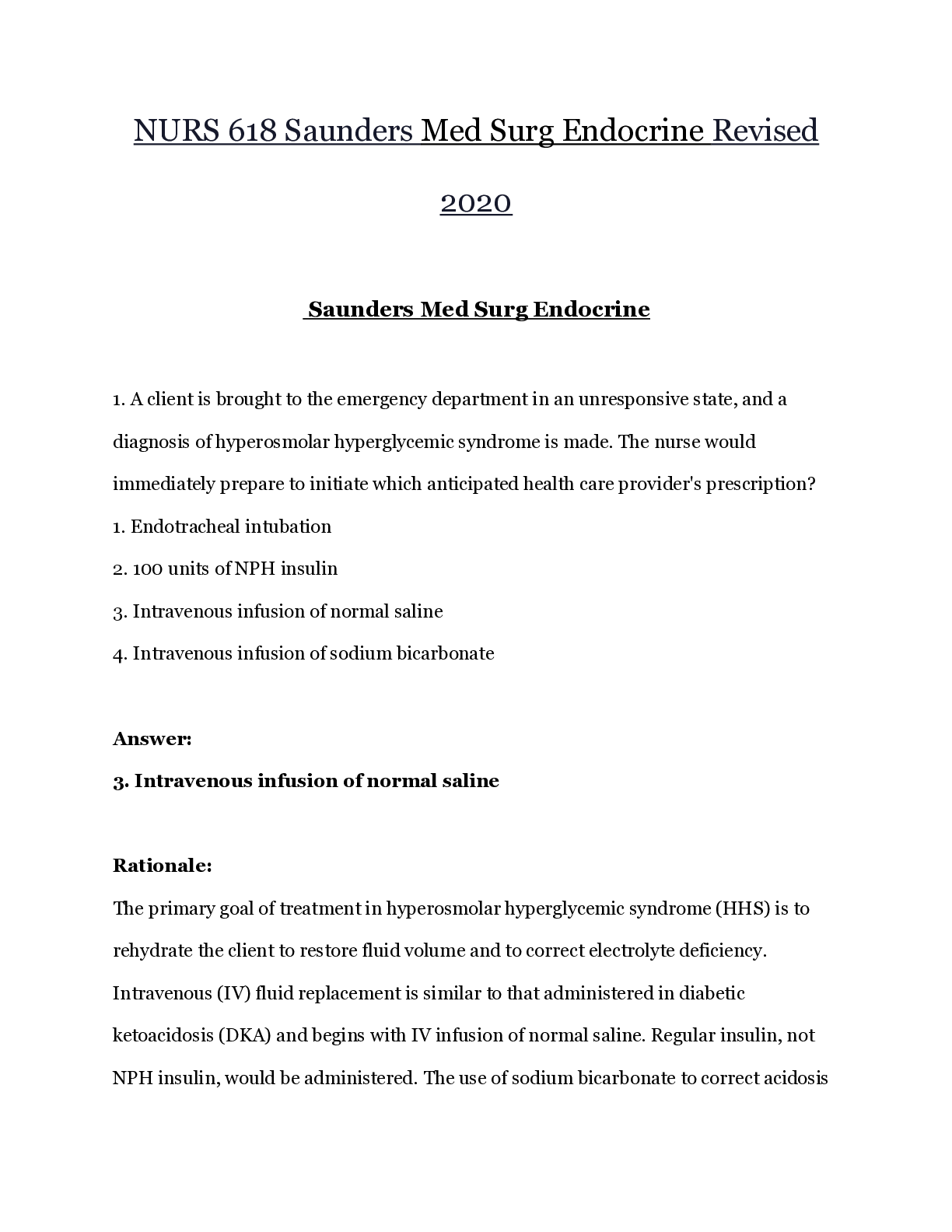
Reviews( 0 )
Document information
Connected school, study & course
About the document
Uploaded On
Nov 07, 2020
Number of pages
99
Written in
Additional information
This document has been written for:
Uploaded
Nov 07, 2020
Downloads
1
Views
73

